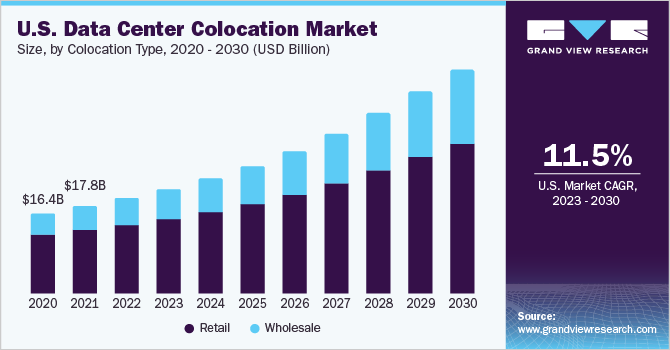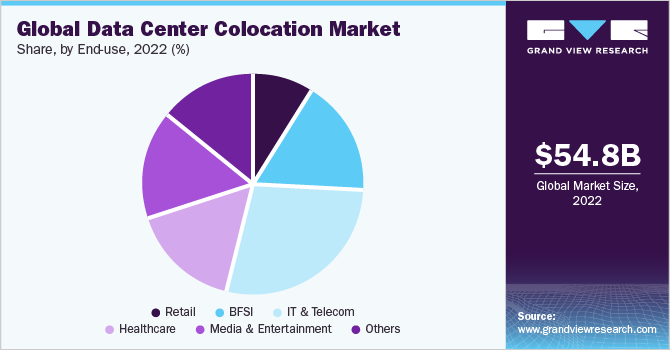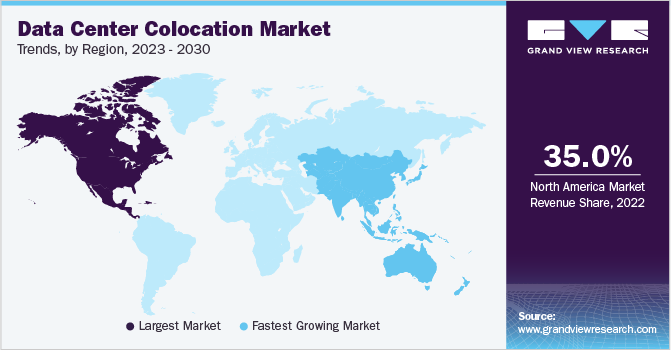- Home
- »
- Communications Infrastructure
- »
-
Data Center Colocation Market Size & Share Report, 2030GVR Report cover
![Data Center Colocation Market Size, Share & Trends Report]()
Data Center Colocation Market Size, Share & Trends Analysis Report By Colocation Type (Retail, Wholesale), By Enterprise Size (Large, SMEs), By Tier Level (Tier 1, Tier 2), By End-use (BFSI, Retail), By Region, And Segment Forecasts, 2023 - 2030
- Report ID: GVR-4-68038-583-0
- Number of Report Pages: 150
- Format: PDF, Horizon Databook
- Historical Range: 2018 - 2021
- Forecast Period: 2023 - 2030
- Industry: Technology
Report Overview
The global data center colocation market size was valued at USD 54.82 billion in 2022 and is expected to grow at a compound annual growth rate (CAGR) of 14.2% from 2023 to 2030. Data centers are a major part of modern corporate practices responsible for administering business applications. The need for IT infrastructure for running businesses has increased over the years as businesses become more dependent on data, which has further resulted in the higher adoption of cloud services. Colocation data centers have enabled quick scaling up of IT requirements of businesses. Moreover, higher costs of owning and maintaining data centers, for companies to generate inconsistent data volumes, have been a key factor driving the market growth.

The emergence of technologies, including cloud computing, autonomous vehicles, Internet-of-Things (IoT), and advanced robotics, has resulted in a higher demand for faster data processing and higher bandwidth. The successful usage of these technologies requires lower latency and faster network connectivity. Colocation data centers are best suited to meeting low latency and faster network connectivity requirements as the operators can locate their data center facilities that are nearby to the users, enabling them to offer greater storage and networking services. The emergence of 5G technology is expected to increase the deployment of colocation services, owing to the capability of colocation providers to offer services in remote locations.
The increasing adoption of cloud data centers, attributed to reduced costs, is expected to fuel market growth. SMEs are increasingly adopting cloud services owing to factors, such as eliminating the need for IT staff, scalable low costs, and having lesser overheads. Several major companies in the market have been developing various strategic initiatives, including partnerships, acquisitions, and mergers, among others, to get better traction in the market. For instance, in May 2022, Cyxtera announced its colocation solution offerings in India, achieved by a strategic partnership with Sify Technologies Ltd. As a part of the partnership, Sify Technologies Ltd. will resell Cyxtera’s solutions across markets in Asia Pacific, Europe, and North America to more than 10,000 customers.
The customers will also be able to access Digital Exchange, enabling companies to deploy every IT infrastructure on-demand and providing the foundation for modernizing operations to compete in the digital world. The emergence of technologies, such as 5G, AR, VR, and AI, has also resulted in high demand for allocating higher bandwidths for data sharing between businesses. Moreover, the need for data center colocation has increased due to the continued adoption of various technologies, such as advanced robotics and autonomous vehicles. These technologies' constant expansion has contributed equally to the adoption of smart devices, thereby driving the need for lower latency. Colocation enables cloud service providers to set up their data centers in proximity to users, enabling low latency and high bandwidth in data transfer.
The need for high-capacity networks has risen with the advancement into edge-computing applications. Businesses are also shifting toward the cloud, which created the demand for seamless data transfers and faster data processing. These solutions provide a step towards cloud migration, which boosts market growth. However, certain cons, which include being a shared facility and having no control over the location, upgrades, and servicing management by the business, may hinder growth. On the other hand, the pros which include better connectivity, improved network security, redundant power supply, bursting capability, and room for growth, outweigh the cons of data center colocation, attracting businesses and accelerating market growth.
Colocation Type Insights
The wholesale colocation segment is projected to witness the highest growth rate of over 17% over the forecast period. Major cloud service providers have been moving towards colocation, aimed at targeting large enterprises, owing to their wider customer base, which would generate a large volume of data and the need for large commercial space for keeping the servers. This aspect has been a significant factor in driving the growth of the whole colocation segment among large enterprises, thereby driving market growth.
The retail colocation segment accounted for the largest share of over 70% of the overall revenue in 2022 and is expected to continue its dominance over the forecast period. Retail colocation type enables businesses to rent smaller spaces within a data center, which allows businesses to manage smaller volumes of data and requires limited infrastructure. This has been a major factor in driving the adoption of retail colocation among SMEs. In addition, the low-budget requirement has also been attracting SMEs towards retail colocation.
Enterprise Size Insights
The SMEs segment is projected to witness the fastest growth rate of over 16% over the forecast period. The growth of the SME segment can be attributed to the benefits for SMEs when they opt for data center colocation, which includes scalability, reliability, security, cost-effectiveness, flexible rack sizes, and portability, among others. The presence of major companies in the market, STL Tech, Iron Mountain Inc., and Volico Data Centers, offering solutions for SMEs has also been driving the growth of the SME segment.
The large enterprise segment accounted for the maximum share of more than 60% of the overall revenue in 2022. The high share of the segment can be attributed to the rising product demand among large businesses for managing and maintaining data efficiently. Large enterprises across various sectors are generating large volumes of data, for which large infrastructure and high storage capacities for storing & processing the large data are required. This has been driving the growth of the large enterprise segment.
Tier Level Insights
The tier 3 segment accounted for the largest share of around 45% of the overall revenue in 2022 and is projected to continue growing over the forecast period. A tier 3 data center has multiple paths for cooling and power systems to update and maintain it without being offline and has an expected uptime of 99.982%. Some significant benefits of tier 3 colocation data centers include high availability, redundant infrastructure, scalability, and enhanced security.
The tier 4 segment is projected to witness the fastest growth rate of 16% over the forecast period. A tier 4 data center offers an expected uptime of 99.995%. Moreover, it provides high security, better flexibility & scalability, a lower budget, and a 2N+1 fully redundant infrastructure. These have been significant factors in driving the growth of the tier 4 segment growth.
End-use Insights
The healthcare end-use segment is projected to register the fastest growth rate of over 19% from 2023 to 2030. The growth of the healthcare segment can be attributed to healthcare organizations shifting from legacy infrastructure to off-premises, better network uptime with the redundancy of colocation service providers, reduced operational costs and better resource allocation, a wider range of connectivity options, and minimized risk through better security compliance among others. The IT & telecom segment is held the largest market share of more than 25% in 2022.

The growth of the IT & telecoms segment can be attributed to various strategic initiatives undertaken by key companies aimed at enhancing the telecom and data center colocation ecosystem. For instance, in February 2023, Google announced a collaboration with StarHub. StarHub will explore Google Cloud’s data management, ML, and AI tools for its network operations and enhance the customer experience as part of the partnership. Google has also announced telecom innovations for helping Communications Service Providers (CSPs) to transform their networks with hybrid cloud principles digitally.
Regional Insights
North America accounted for more than 35% share of the overall revenue in 2022 and is projected to continue its dominance over the forecast period. The growth of the regional market can be attributed to the presence of major CSPs and SMEs deploying colocation data centers across the region. Some major companies originating in the North America data center colocation market include Cyxtera Technologies, Inc., Digital Realty Trust, Inc., and CyrusOne, Inc. among others. The retailers in the region have been heavily investing in the IT infrastructure for storing & analyzing customer data, their buying patterns, and products in demand, among others.

This has also contributed to the regional market growth. The Asia Pacific region is projected to witness the fastest growth rate of over 19% over the forecast period. The growth of the Asia Pacific regional market can be attributed to various factors, such as improving digital infrastructure, rapid digitalization, the presence of top data center colocation providers, the increasing number of data centers set up in the region, and the presence of countries, such as China and India, which are the top manufacturing centers in the world. All the factors combined have contributed to the region's growth in the global market.
Key Companies & Market Share Insights
The market has a fragmented competitive landscape featuring various global and regional players. Leading industry players are undertaking strategies, such as product launches, collaborations, and partnerships, to survive the highly competitive environment and expand their business footprints. For instance, in November 2022, Colovore announced setting up its second data center location in Santa Clara. The new data center setup will deliver 9MW high-density liquid-cooled colocation capacity, which features 50kW per rack capabilities. Various companies have been involved in partnerships to set up data centers in new locations, which has enhanced capabilities. For instance, in February 2023, Web Werks and Iron Mountain launched its first greenfield data center in Navi Mumbai, India, named MUM-2. The data centers cover a 120,000 sq ft campus, a tier 3 data center with a total gross power capacity of 10MVA. Some of the prominent players operating in the global data center colocation market are:
-
China Telecom Corporation Ltd.
-
Cologix
-
Colt Technology Services Group Ltd.
-
CoreSite
-
CyrusOne
-
Cyxtera Technologies, Inc.
-
Digital Realty Trust
-
Equinix, Inc.
-
Flexential
-
Iron Mountain Inc.
-
NTT Ltd.
-
QTS Realty Trust, LLC
-
Rackspace Technology
-
Telehouse
-
Zayo Group, LLC
Data Center Colocation Market Report Scope
Report Attribute
Details
Market size value in 2023
USD 61.47 billion
Revenue forecast in 2030
USD 155.40 billion
Growth rate
CAGR of 14.2% from 2023 to 2030
Base year for estimation
2022
Historical data
2018 - 2021
Forecast period
2023 - 2030
Report updated
June 2023
Quantitative units
Revenue in USD billion, and CAGR from 2023 to 2030
Report coverage
Revenue forecast, company market share, competitive landscape, growth factors, and trends
Segments covered
Colocation type, enterprise size, tier level, end-use, region
Regional scope
North America; Europe; Asia Pacific; Latin America; Middle East & Africa
Country scope
U.S.; Canada; UK; Germany; France; Austria; Switzerland; Benelux; Nordics; CEE; China; India; Japan; Australia; South Korea; Brazil; Mexico; Argentina; UAE; Saudi Arabia; South Africa
Key companies profiled
China Telecom Corp. Ltd.; Cologix; Colt Technology Services Group Ltd.; CoreSite; CyrusOne; Cyxtera Technologies, Inc.; Digital Realty Trust; Equinix, Inc.; Flexential; Iron Mountain Inc.; NTT Ltd.; QTS Realty Trust, LLC; Rackspace Technology; Telehouse; Zayo Group, LLC
Customization scope
Free report customization (equivalent to up to 8 analysts working days) with purchase. Addition or alteration to country, regional & segment scope
Pricing and purchase options
Avail customized purchase options to meet your exact research needs. Explore purchase options
Global Data Center Colocation Market Report Segmentation
This report forecasts revenue growth and provides an analysis of the latest trends in each of the sub-segments from 2018 to 2030. For this report, Grand View Research has segmented the global data center colocation market report based on colocation type, enterprise size, tier level, end-use, and region:
-
Colocation Type Outlook (Revenue, USD Billion, 2018 - 2030)
-
Retail
-
Wholesale
-
-
Tier Level Outlook (Revenue, USD Billion, 2018 - 2030)
-
Tier 1
-
Tier 2
-
Tier 3
-
Tier 4
-
-
Enterprise Size Outlook (Revenue, USD Billion, 2018 - 2030)
-
Small and Medium-sized Enterprises
-
Large Enterprises
-
-
End-Use Outlook (Revenue, USD Billion, 2018 - 2030)
-
Retail
-
BFSI
-
IT & Telecom
-
Healthcare
-
Media & Entertainment
-
Others
-
-
Regional Outlook (Revenue, USD Billion, 2018 - 2030)
-
North America
-
U.S.
-
Canada
-
-
Europe
-
UK
-
Germany
-
France
-
Austria
-
Switzerland
-
Benelux
-
Nordics
-
CEE
-
-
Asia Pacific
-
China
-
India
-
Japan
-
Australia
-
South Korea
-
-
Latin America
-
Brazil
-
Mexico
-
Argentina
-
-
Middle East & Africa
-
UAE
-
Saudi Arabia
-
South Africa
-
-
Frequently Asked Questions About This Report
b. The global data center colocation market size was estimated at USD 54.82 billion in 2022 and is expected to reach USD 61.47 billion in 2023.
b. The global data center colocation market is expected to grow at a compound annual growth rate of 14.2% from 2023 to 2030 to reach USD 155.40 billion by 2030.
b. The retail type segment dominated the data center colocation market with a share of over 70 % in 2022, and is estimated to retain the leading position throughout the forecast period.
b. The IT & telecom segment led the global data center colocation market with a revenue share of around 28% in 2022. The high share of this segment is attributed to the increased number of mobile internet users and the continued development of new applications and software in the industry.
b. North America was the dominant regional market for data center colocation and accounted for a revenue share of around 40% in 2022. The region is estimated to expand further at a significant CAGR from 2023 to 2030 due to the strong presence of several major cloud service providers and SMEs deploying colocation data centers.
b. The large enterprises segment dominated the data center colocation market in 2022 with a share of over 60%. This high share is attributable to the high product demand among large organizations to manage and maintain data efficiently.
b. Some key players operating in the data center colocation market include Cyxtera Technologies, Inc.; Global Switch; CyrusOne, Inc.; Telehouse; NTT Communications Corporation; Digital Realty Trust, Inc.; NaviSite; and Equinix, Inc.
b. Key factors that are driving the data center colocation market growth include benefits such as reduced capital expenditure, uptime reliability, lower costs, fewer technical staff, easy scalability, and predictable monthly or yearly expenses.
Share this report with your colleague or friend.
![gvr icn]()
NEED A CUSTOM REPORT?
We can customize every report - free of charge - including purchasing stand-alone sections or country-level reports, as well as offer affordable discounts for start-ups & universities. Contact us now
![Certified Icon]()
We are GDPR and CCPA compliant! Your transaction & personal information is safe and secure. For more details, please read our privacy policy.
We are committed towards customer satisfaction, and quality service.
"The quality of research they have done for us has been excellent."





